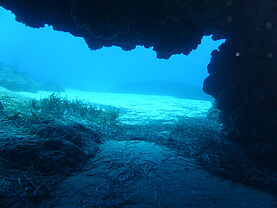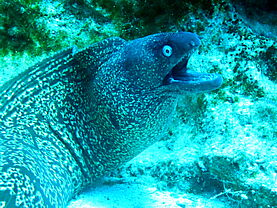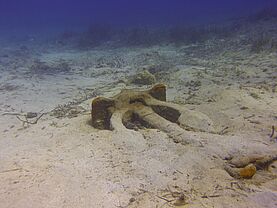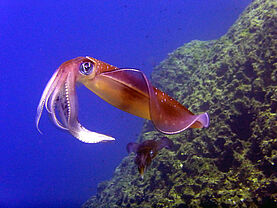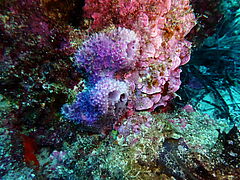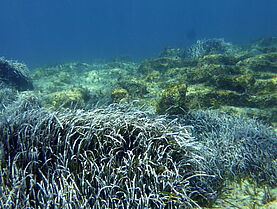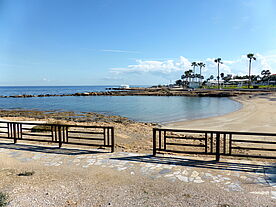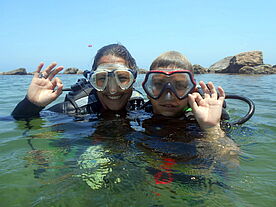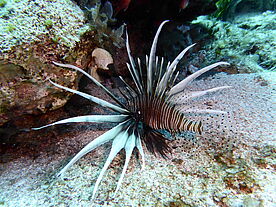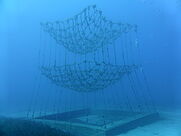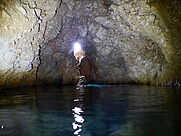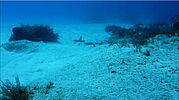Green Bay 1
Here we dive mainly with beginners and introductory divers. Easy to get in and out. Maximum depth is 10 meters. There are also some amphora shards, monk fish, gobies, starfish, sea peacocks, squid, moray eels, breams and also groupers. Sometimes also Spanish dancers, turtles and large nudibranches. Right at the exit of the bay you come to a rock with so many monk fish and breams that you think you are in an aquarium. And in 9 meters depth we meet stone columns and stone figures. This is always a highlight for our divers, because you get some really great photos there.
Green Bay 2
This is a place with several caves. A large cave, through which you can also dive, is located at a depth of 18 meters. In the cave you can often see spanish lobbsters andThere are again many monk fish, groupers, bream, sea peacock, moray eels and squid. For divers with good air consumption you can dive around the island on the way back and you will come out in Green Bay 1. A nice dive that lasts about 55 minutes.
Cape Awkward 1
Here it goes down the hill a bit. At the entry point there is a plateau with a slight slope from 2 to 12 meters depth. If you dive over to the right, a wall drops down to 10 meters. Down there everything is full of seaweed. Attention: In this sea grass you can often see morays, so open your eyes! There are several small inlets which are very suitable for underwater photography. If you dive further east you come to a sandy slope, which looks like a ski slope, because the sea grass field divides. This looks really good. Here we dive up the slope and you get to an impressive wall, which looks especially beautiful in the morning when the sun is shining onto the wall. On the way back we mostly dive in the 10 to 12 meter range passing some smaller inlets. At this dive site you can again see moray eels, groupers, trumpet fish and monk fish. Here we meet most of the lionfish. In May and June you can also admire large schools of barracuda. At 30 meters and deeper, we often see veilsnails of considerable size.
Cape Awkward 2
The entry point is the same as at Cape Awkward 1. After the entry we dive slightly to the right, i.e. west-southwest, to a maximum depth of 20 meters and then pull up permanently into shallower water. Here we find the smallest sand dollars, which only have a diameter of about 5 millimeters. Further on this is a good place with its small sandbanks and sea grass areas for turtles. In the stony region you can find octopuses again and of course morays and plenty of sea urchins with spikes as long as 30 cm. A dive site that is suitable for all levels of divers.
Chapel 1
The chapel, the place where many weddings are held on weekends. A few steps lead down to a large cave above the water level. According to tradition, in the early days, the men and women captured by the pirates and destined for the slave market were kept in this cave. In this cave they could be guarded with minimal effort until they were loaded onto ships. With a big step you reach the entrance plateau. It falls rather steeply down and one gets very quickly to depth. At 20 meters it flattens out a little and then slowly descends to 30 - 40 meters and deeper. During this dive we mostly stay at 20 meters and dive over left into the bay. You can see nudibranchs, squid, monk fish, bream, sea peacocks and sometimes spanish lobsters. In the bay at a depth of 5 meters you can see a huge area of amphora remains that have grown together.
Chapel 2
The same entry point as at Chapel 1, but here we dive straight ahead along a wall out into the open water. At the beginning we stay at about 12 meters depth. Here we pass over eelgrass until we reach the sloping stone slope. The depth here is 27 meters. A spectacle of colours, sponges, tube worms, purple rock roses, groupers and morays. An exhilaratingly beautiful dive site and it stretches over a beautiful stretch. An excellent dive site, but only suitable for divers with good air consumption. On the way back it goes permanently shallower passing sandy depressions and in the rock caves you can see beautiful big Neptune Bearded Corals.
Caves and Cavern
Probably the most spectacular dive site in this area with some cave systems. The average depth is not more than nine meters. The maximum depth lays by 16 meters. The way down to the entry point is a bit "bumpy", but the path was levelled in September 2007 and it is now much easier to get to the entry point. This dive is worth every effort. Already at the entry point you stand over a cave where you can dive into. You pass a wall in southern direction over some rocks. After that it becomes flat and the bottom is sandy. After about 50 meters you can see a cave system on the left side. You can also dive through it. From the exit point you turn right at an angle of 90 degrees and come to an overhang. After that you will reach the big cavern. The cavern entrance is about 1.5 meters high and inside the cavern expands. An incredible sight. On the ceiling you can see "Neptune Beards", a very fragile coral species. After about five meters you can see a big hole with a diameter of two meters in the ceiling, through which you have direct access to the surface should need arise. After that you go through the last two thirds of this cavern. Here it gets a bit lower, but there is still enough space for two divers next to each other. The bottom consists of large pebbles and therefore visibility is almost always good. Great for underwater photography. After the exit of the cavern you turn right into a small canyon with many small caves and a rich variety of fish. On the sandy way back you can almost always see stingrays. Near the stingrays there are often flounders and cleaver fish. 2 different morays can be seen there as well. Once the native "moray eel Helena" and an immigrated one from the Red Sea
Antennas
This dive site is located near the Caves. It is a very good dive site. The entrance is on a small plateau and it is about two meters deep at the entry point. It then goes past large pebbles down to 13 meters where it becomes sandy. Here you can often see ton shells and stingrays. Sometimes we also see big cone snails. From the sandy ground we turn right towards the caves. On the way back there are some bigger aisles towards the wall which are worth a closer look. The last third of this dive site is especially beautiful due to the bottom. You have a beatiful variaty of rocks, hollows, sand and smaller caves. Near the exit point you often see groups of trumpet fish.
Dacosta Bay
A beautiful and quiet dive site, suitable for all levels of certification with a maximum depth of 12 meters. Please keep your eyes open and search the rocks, you can often find beautiful umbrella snails of about 15 cm and also spanish lobsters. Turtles as well can often be spotted there. Nice for dives early morning to enjoy the sunrise. Yes, we also dive at 5:30 in the morning if our divers wish so.
Magumaerha Bay - House Bay
Our house bay, less than 80 metres from the base with a sandy beach that is not overcrowded and a maximum depth of 8 metres. A breakwater protects the bay. In the shallow area it is sandy and then it turns into a stony bottom. Here we do our Bubble Maker programs, Discover Scuba Dives and also different courses. Perfect for training in a safe and comfortable environment. Also perfect for night dives. You can often see trumpet fish, sea needles, squid, cuttlefish, barrel snails, crabs, soldier fish and sometimes turtles.
Canyon
A brilliant wall dive with some smaller caves. Here you need a small ladder to get to the entry point. Maximum depth is 18 meters. Cone snails are in their thousands on the sandy bottom. Also monk fish, moray eels, groupers, soldier fish, ornate and rainbow wrasses and also stingrays can be found. There are also 3 little islands covered with sea grass out there which are worth a closer look. A beautiful dive site. Especially in the morning sun.
The Trench
This Trench runs from Green Bay down to Cape Awkward 1. The dive site is also called STEPS because there are concrete steps, which makes it very easy to get in. Diving along the coastline, we are at a depth of 15 meters. Perfect for a relaxing dive. If you dive towards the open sea you will comfortably reach a depth of 25 meters. The bottom changes from rocks and sandy parts to sea grass and stone slabs. This dive site surprises again and again with stingrays, morays and gurnards. Furthermore you can also find here many soldier fish, trumpet fish, monk fish and different kinds of crabs.
The artificial Reef
The REEF is located very close to the wrecks *LIBERTY* and *NEMESIS III*. To this artificial reef we go out by boat. At the deepest point we reach maximum 23 meters and this dive site is also very suitable for not so experienced divers. Highly recommended for all underwater photographers. This artificial reef was created in cooperation with the Fisheries Department, CTO and the Paralimni community. This dive resembles a guard run. You start at a rope pyramid, continue on to two large concrete blocks with many crevices, then we pass a large pile of stone blocks and concrete pipes lying on the bottom in *T* form. Just perfect for beautiful pictures. This dive site offers a variety of UW creatures like lionfish, moray eels, triggerfish, monk fish, groupers and plenty of shells.
Bat Cave
This bat cave is unique in its presentation and is simply rated by our divers as a *brilliant dive*. It is located near Xylophagou and can only be reached by boat. We always combine two dives here. First we dive the wreck of the *CRICKET* and then we go over to the *BAT CAVE*. In the 5 meter deep water we dive up to the rock wall to the entrance of this beautiful cave. For the first cave we keep a bit to the left and dive slowly upwards until we reach a dome, which is above the water level. It looks simply fascinating in there. On the wall this stalachnite material pulls itself down and looks like ice. Here you can take really beautiful pictures. After this first cave we make our way to the second cave, which is right next door. It offers space for 5 divers and the light reflections and the turquoise green water makes it an unforgettable dive. A MUST for every diver.
Octopus Reef
The Octopus Reef is a new dive site and has only been in our program since one year. Every diver was enthusiastic about this dive site so far. This dive site is located a bit further out than the Liberty and Nemesis and is approached by Zodiac. The depth is between 28 and 31 meters. This dive requires a Nitrox mix to get a reasonable dive time. You will descend at the anchor rope. From time to time we have some current there which is not really a problem.
Already during the descent you often see Venus Belts. When we reach the bottom we come across a large rocky plateau which offers us see many interesting things. Big black leather sponges and funnel sponges, the flat top of this plateau is covered with these sponges. This is the right place for our lionfish which are close to or directly at the sponges. Sometimes we counted 15 lionfishes staying around those big sponges. We have morays, starfish, purple sea slugs, cuttle fish, scissor shrimps and many more. A paradise for underwater photographers.
Pinacle Reef
Also the Pinacle Reef is a new dive site and has only been in our program for one year. Again we use a Zodiac for our Transport to the dive site. Driving out of the Golden Coast harbour we turn right and heading along the coast until we reach the hight of the Vrissiana Beach Hotel. There we make a 90 degrees turn to the left and continue out into the open sea. Also here we have a depth of 28 to 31 meters. A good indea to use on this dive as well a Nitrox mixture in order to get a good dive time. We descend again at the anchor rope. Also in this dive we have to be prepared for a possible current. .
During the descent you can see already the whole dive site, a big rocky plateau which runs all around into the sand. This riff offers us as well many interesting things. Like at the Octopus reef we will find big black leather sponges and funnel sponges. The flat top of this plateau is also covered with these sponges. This is the right place for our lionfishes which are close to or directly at the sponges. Furthermore we have morays, starfish, purple colored sea slugs, cuttlefish, scissor shrimps, sometimes turtles and much more. Another paradise for underwater photographers.
![[Translate to English:] [Translate to English:]](/fileadmin/_processed_/5/1/csm_Herbies_Favorite_c9d530a027.jpg)


![[Translate to English:] [Translate to English:]](/fileadmin/_processed_/4/f/csm_Large_Barakuda_e2ab76ed8b.jpg)






![[Translate to English:] [Translate to English:]](/fileadmin/_processed_/5/6/csm_Katja_Patricia_Wolfgang_c2ae043e0b.jpg)

![[Translate to English:] [Translate to English:]](/fileadmin/_processed_/2/2/csm_Wolfgang_Grouper_30d0c1b308.jpg)

![[Translate to English:] [Translate to English:]](/fileadmin/_processed_/3/f/csm_Katja_Seaslug_Nem_7d66d05fb7.jpg)







